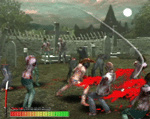Simple 2000 Series Vol. 61: The Oneechanbara
 D3 Publisher are honest about their design and business goals: they produce budget-priced software that takes a simple concept – often one already established by full-priced games – and build a game around it that conforms to their very limited production budgets and schedules. Other times their concepts are original and experimental (something the nature of the budget game often allows), and still other games are obvious ripoffs upon which D3 has put their own spin.
D3 Publisher are honest about their design and business goals: they produce budget-priced software that takes a simple concept – often one already established by full-priced games – and build a game around it that conforms to their very limited production budgets and schedules. Other times their concepts are original and experimental (something the nature of the budget game often allows), and still other games are obvious ripoffs upon which D3 has put their own spin.
The Oneechanbara is an example of the latter. It’s an earnestly B-rate take on the sort of polygonal killing spree made possible by the current console generation’s technology and made popular by the Dynasty Warriors series. The victims in this case are zombies, and the player character is a bikini-and-lacy-scarf-clad young woman with a cowboy hat and boots who wields a katana. And unlike Koei’s Teen-rated series, enemies do bleed here. Regardless of how long the undead may have been roaming, they still shed the red stuff freely, and blood spatters the walls and floors constantly. It earns every bit of its CERO 18 rating. “Oneechanbara” is a pun: “oneechan,” literally “older sister,” is used as slang to refer to an attractive woman, and “chanbara” is slang for violent slice-em-up samurai B-movies.
Gameplay is interesting in concept and enjoyable in practice. It’s possible to execute several different multi-hit combos, as well as a crowd-clearing horizontal slice and a launcher. Each slice at the enemy leaves a bit of blood on Aya’s sword, and the amount thereof is measured by a meter. When the meter is full, the sword radiates a dark energy and does more damage, but it also becomes prone to sticking in the torsos of undead. This leaves Aya open to attacks for a few seconds. Pressing L1 makes her fling the blood from her blade, spattering it on the ground and leaving the sword clean. It’s a gruesome and pleasing effect that recalls violent anime and samurai or yakuza movies. Blood also drives a second meter: as Aya offs more zombies, she gradually becomes covered with blood. When this meter fills, she enters a berserk rage that increases her speed and strength while rapidly draining her health. Aya becomes surrounded by a red haze and leaves bloody trails behind her weapon, and her kills count easily rocket while in this mode. If she doesn’t use a health item by the time the blood meter drains, it’s easy to find oneself looking at a game over screen.
The final meter present measures experience. Upon death, some enemies will drop yellow orbs that add to the meter, and when the meter is full, the player can add one point to an attribute of his or her choice. The game encourages skillful attack strategies and meter management with two combo counters: one for hits and another for kills. High combo scores will grant recovery, experience, and stat-enhancement items, and count toward the various requirements for unlockables.
It’s clear that the bulk of the game’s budget was spent on the core gameplay systems and player model, as the rest of the game is drab and redundant. Environmental textures are blurry, level layouts are boring, and level resources (including entire levels) are recycled multiple times. There are a few different enemy types, but this variety isn’t enough to keep the game interesting past the second level or so. Each level is drawn out by respawning enemies, backtracking, and key-hunts, and everything feels obviously padded for length. This includes the requirements for unlockables: there are ten sets of requirements, and for each a task (kill every enemy, go into blood rage five times, etc) must be completed on each level of the game. The first costume is unlocked after six of these sets are fulfilled. Most of the six costumes available are texture swaps of only a couple of models, but the final ‘costume’ is Aya’s evil younger sister, who feels different enough to offer a slightly new experience. Others may have the patience and free time to go through the game enough times to unlock costumes manually, but this reviewer did not (preferring rather to determine and use the unlock-all code).
As it is, the game is definitely recommendable as a curiosity and to anybody looking for a cheap, prurient thrill. Cutting through hordes of enemies and spraying blood everywhere is satisfying and fun for as long as the thrill lasts, and the game’s survival mode is the best way to experience this in the short bursts for which it’s best. One should not, however, expect a fully-realized game experience. As it is, The Oneechanbara is a prime example of the D3 philosophy, and while its budget could have been more evenly distributed, that would likely have reduced the merits it does have and led to it not being recommendable at all.
Video (D3 Publisher)
Official Site (D3 Publisher)
Unlock-all code: (at title screen) Up Down Up Down L1 R1 L2 R2 L3 R3 Up Down Up Down L1 R1 L2 R2 L3 R3